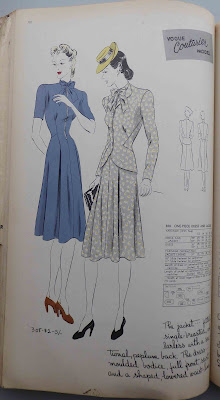 |
| Happiness is a cardigan which is the right length! |
When I last posted about this, I had knitted the fronts and nearly completed the back. Once the back was done, the next stage was to knit up the shoulder seams. Knitting off two needles onto one and casting off at the same time was an entirely new idea for me, but produces a very neat join. Next came the button and buttonhole bands. Tasha provides various options for the neck band/collar, but I decided to keep it simple for this version and just do the basic neck band. The neck ties are knitted as i-cords - two stitches knitted in the round. Something else new, and great fun to do.
Then it was on to the sleeves. Tasha's method of working involves knitting everything as part of the garment, not as separate pieces. This means that the sleeves are knitted top down from the armhole. That was a lot of stitches (118 for my size) to space out evenly, so I followed the tip provided and split it up into smaller sections.
 |
| The armhole divided into sections |
Even these seemed a bit tricky, so I ended up marking the approximate pick-up point for each stitch within a section with pins.
 |
| Even more detail |
The sleeve decreases by two stitches on every third row, and eventually got too small for the circular needle I was using. I changed onto double-pointed needles, as that was all which my local shop had. Unfortunately I didn't think to check my progress for a while and when I did, I discovered that despite my best efforts to pull the stitches tight, there was very obvious laddering at the joins.
 |
| Sigh |
Luckily, an online search for a solution alerted me to the fact that smaller circular needles exist! I ordered some online, and patiently unpicked 18 rows of sleeve while I waited for them to arrive (sad trombone).
After that, it was plain sailing. I really like the fact that this method of construction means that there's no sewing together of various pieces to do at the end. The only sewing was adding petersham ribbon to the button bands to strengthen them, and overcasting the buttonholes in the ribbon. I spent an absurd amount of time trying to decide if the buttonholes in the ribbon should be horizontal or vertical before thinking to read Tasha's excellent, comprehensive, instructions, which confirmed that they should be vertical.
 |
| Buttonholes |
When I planned this project, I was so doubtful about my ability to complete it that I didn't want to spend a lot of money on expensive yarn. So it is made from an acrylic and as a result, I'm not sure how effective blocking it actually was, but I did it anyway.
 |
| Blocked, and showing the very short body length |
Finally, I added buttons from my stash.
 |
| Auditioning buttons - I went with the middle ones |
The end result can be worn over a dress, extending the wearing season of sleeveless dresses such as Butterick 6582, while the batwing sleeves will also make it easy to wear over styles with grown-on sleeves, such as Vogue 5215.
 |
| Worn over Butterick 6582 |
Alternatively, Wondrella works well with a skirt - although I am glad that I shortened the keyhole neckline opening a little!
 |
| Worn with my back-to-black skirt |
Either way, I can see this cardigan getting a lot of wear, and I really can't recommend the pattern enough (the link to Tasha's website is here, if you want to have a go yourself). I'm not a knitter - the only other garment I've ever knitted was a jumper in the early 1980s with minimal shaping in a very fuzzy yarn which hid multiple crimes against tension and sewing up - but even with just knowing the knitting basics I was able to make something which I was proud to wear out to the Festival of Vintage today. I suspect another version will be on my needles soon.









































